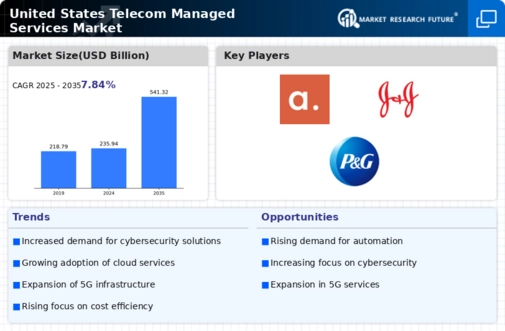Emergence of 5G Technology
the rollout of 5G technology is set to revolutionize the telecom managed-services market. With its promise of ultra-fast connectivity and low latency, 5G enables new applications and services that were previously unattainable. The market for managed services related to 5G deployment is projected to grow significantly, with estimates suggesting an increase of over 15% annually. This growth is driven by the need for infrastructure upgrades and the management of complex networks that 5G entails. Service providers are tasked with ensuring seamless integration and operation of 5G networks, which requires specialized knowledge and resources. Consequently, the emergence of 5G technology is likely to create substantial opportunities within the telecom managed-services market.
Regulatory Compliance and Standards
Regulatory compliance remains a critical driver in the telecom managed-services market. As telecommunications regulations evolve, companies must adapt their operations to meet stringent requirements. In the US, the Federal Communications Commission (FCC) enforces various standards that impact service delivery and data protection. Non-compliance can result in substantial fines, prompting organizations to seek managed services that ensure adherence to these regulations. The market for compliance-related managed services is expected to grow by approximately 8% annually, as businesses prioritize risk management and legal conformity. This trend underscores the importance of partnering with managed service providers that possess expertise in navigating the complex regulatory landscape, thereby enhancing the overall credibility and reliability of the telecom managed-services market.
Increased Focus on Customer Experience
Enhancing customer experience has become a pivotal focus for businesses operating within the telecom managed-services market. As competition intensifies, organizations are compelled to differentiate themselves through superior service delivery. In 2025, the market for customer experience management solutions is expected to grow by approximately 9%, driven by the demand for personalized and responsive services. Managed service providers are increasingly leveraging data analytics and customer feedback to tailor their offerings, ensuring that they meet evolving consumer expectations. This emphasis on customer satisfaction not only fosters loyalty but also drives revenue growth, thereby reinforcing the importance of customer experience initiatives within the telecom managed-services market.
Growing Demand for Network Optimization
The telecom managed-services market experiences a notable surge in demand for network optimization solutions. As organizations increasingly rely on efficient communication networks, the need for enhanced performance and reliability becomes paramount. In 2025, the market for network optimization services is projected to reach approximately $15 Billion, reflecting a growth rate of around 10% annually. This trend is driven by the necessity for businesses to maintain competitive advantages through superior connectivity. Moreover, the integration of advanced analytics and monitoring tools within managed services allows for real-time adjustments, ensuring optimal network performance. Consequently, service providers are compelled to innovate and offer tailored solutions that address specific client needs, thereby fostering growth within the telecom managed-services market.
Shift Towards Managed Security Services
the increasing prevalence of cyber threats has led to a shift towards managed security services within the telecom managed-services market. Organizations are recognizing the necessity of robust security measures to protect sensitive data and maintain customer trust. In 2025, the market for managed security services is anticipated to exceed $20 billion, growing at a rate of 12% annually. This growth is indicative of the rising awareness surrounding cybersecurity risks and the need for specialized expertise. Managed service providers are now offering comprehensive security solutions, including threat detection, incident response, and compliance management. As a result, businesses are more inclined to outsource their security needs, thereby propelling the expansion of the telecom managed-services market.

















Leave a Comment